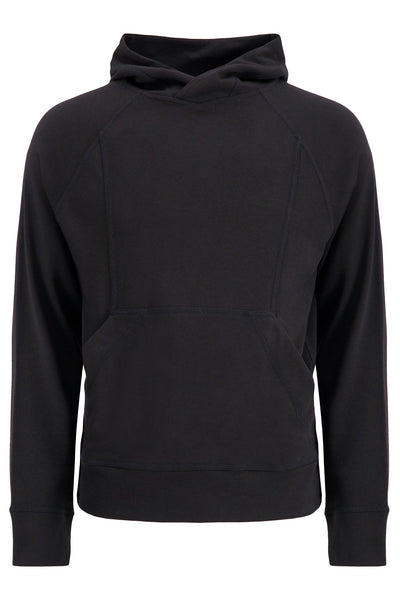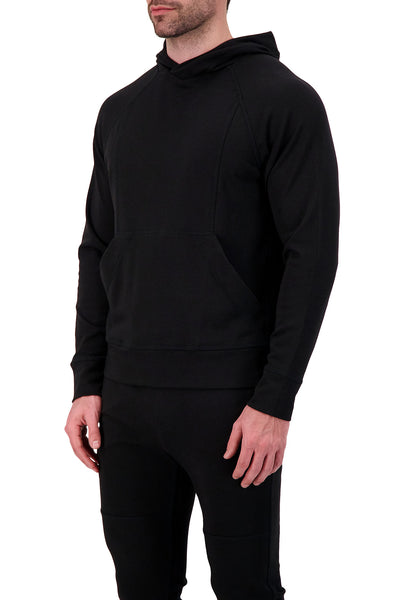Thermal clothing is key to staying warm and comfortable when facing cold temperatures. But how does it work?
In this article, we’ll discuss
- The basics of thermal clothing, including the importance of selecting the proper baselayer
- The science behind how thermal clothing performs
- The materials used in thermal clothing design
- How thermal clothing is made and
- How effective thermal clothing is, including any limitations
Let's dive deep into the science behind this innovative clothing technology from Heat Holders®.
What Are the Basics of Thermal Clothing?
What Is Thermal Clothing?
Thermal clothing, also known as thermals or baselayers, is specifically designed to provide insulation and retain body heat in cold weather conditions. It consists of a layer of fabric that traps air and creates a barrier between the body and the environment.
Thermal clothing is typically made from materials such as polyester, merino wool, or a combination of both. These fabrics are known for their excellent insulating properties and ability to wick away moisture from the body. The trapped air within the fabric acts as an insulator, preventing heat loss and keeping the body warm.
One of the key features of thermal clothing is its ability to regulate body temperature. The fabric is designed to keep the body warm in cold weather but also allows for breathability to prevent overheating during physical activity. This makes thermal clothing suitable for a wide range of outdoor activities, from hiking and skiing to camping and mountaineering.
What Is the Importance of Thermal Clothing?
When exposed to low temperatures, our bodies start losing heat rapidly. Thermal clothing plays a crucial role in minimizing this heat loss by providing an extra layer of insulation. By retaining the body's natural warmth, thermal clothing helps maintain a comfortable temperature and prevents hypothermia or frostbite.
Thermal clothing is particularly important for individuals who work or spend extended periods in cold environments. Whether it's construction workers, outdoor enthusiasts, or individuals living in colder regions, thermal clothing offers protection against the harsh elements.
In addition to providing insulation, thermal clothing also offers other benefits. The moisture-wicking properties of the fabric help keep the body dry by drawing sweat away from the skin. This is especially beneficial during physical activities when perspiration can build up and make the body feel cold and uncomfortable.
Thermal clothing is designed to be lightweight and flexible, allowing for ease of movement. It can be worn as a base layer under other clothing or as a standalone garment, depending on the weather conditions and personal preference.
Overall, thermal clothing is an essential part of any cold-weather wardrobe. It not only keeps the body warm and comfortable but also protects against the elements. Whether planning a winter adventure or simply wanting to stay cozy during chilly days, investing in thermal clothing is a wise choice.
The Science Behind Thermal Clothing
Thermal clothing plays a crucial role when it comes to staying warm in cold weather. But have you ever wondered how it works? Let's explore the science behind thermal clothing and the fascinating mechanisms that keep us cozy and comfortable.
What Is the Role of Insulation?
Insulation is the key mechanism behind the effectiveness of thermal clothing. It's like having a protective shield against the cold. Insulation materials, such as synthetic fibers or natural wool, play a vital role in trapping air molecules within their structure. These air pockets act as a barrier, preventing heat transfer between our bodies and the environment.
Imagine tiny pockets of air nestled within the fabric of your thermal clothing, creating a cozy layer of insulation. These air pockets are excellent at trapping heat, ensuring your body's warmth stays close to your skin. The more air pockets there are, the better the insulation and the warmer you'll feel.

Understanding Heat Transfer
To truly appreciate the effectiveness of thermal clothing, it's essential to understand the various ways heat can be transferred. There are three main methods: conduction, convection, and radiation.
Thermal clothing addresses all three methods to minimize heat loss and maximize comfort. First, by using insulating materials with low thermal conductivity, thermal clothing reduces heat transfer through conduction. This means that even if you touch a cold surface, the thermal clothing will prevent the rapid heat transfer from your body to the object, keeping you warm.
Second, thermal clothing hampers convective heat loss. Convective heat transfer occurs when heat is carried away by moving air or fluids. By trapping air within its fibers, thermal clothing prevents air movement near the skin, minimizing convective heat loss. It's like having a protective shield that keeps the cold air at bay.
Lastly, thermal clothing reflects and absorbs radiant heat, further reducing heat loss. Radiant heat transfer happens when heat is emitted through electromagnetic waves. Thermal clothing is designed to reflect these waves towards your body, ensuring that the warmth generated by your body stays with you.
So, the next time you slip into your cozy thermal clothing, remember the science behind it. The insulation, the prevention of heat transfer through conduction, the reduction of convective heat loss, and the reflection of radiant heat all work together to keep you warm and comfortable in even the coldest of temperatures.
Materials Used in Thermal Clothing
Thermal clothing utilizes a range of materials with excellent insulating properties. These materials are carefully selected to provide optimal warmth while allowing moisture to escape from the body, ensuring comfort in cold weather conditions.
Common Materials and Their Properties
One commonly used material in thermal clothing is wool. Wool is a natural choice due to its ability to retain warmth even when wet. The unique structure of wool fibers creates air pockets that trap heat, keeping the body warm. Additionally, wool has the remarkable property of being naturally breathable, allowing moisture to evaporate and preventing the wearer from feeling damp and uncomfortable.
Synthetic fibers like polyester and nylon are also commonly used in thermal clothing. These materials are known for their lightweight nature and quick-drying properties. Polyester, a synthetic fabric, is highly insulated and helps retain body heat.
It is also moisture-wicking, meaning it pulls moisture away from the skin and allows it to evaporate, keeping the wearer dry and comfortable. On the other hand, nylon is known for its durability and excellent thermal insulation properties. It provides an additional layer of warmth while being lightweight and easy to move in.
Innovations in Thermal Clothing Materials
In recent years, advancements in textile technology have led to innovative materials that further enhance the performance of thermal clothing. These materials not only provide exceptional warmth but also offer improved breathability and comfort.
One such innovation is the use of microfiber fabrics in thermal clothing. Microfiber is a synthetic material made of extremely fine fibers. These fibers are much thinner than human hair, allowing for a higher density of fibers in the fabric. This increased density creates more air pockets, resulting in superior warmth. Microfiber fabrics also have excellent breathability, allowing moisture to escape from the body and keeping the wearer dry and comfortable even during strenuous activities.
Another exciting development in thermal clothing materials is the use of fabrics infused with ceramic particles. These particles have the unique property of reflecting and conserving body heat effectively. When the body heat comes into contact with the ceramic particles, they reflect it towards the body, creating a warming effect. This innovative technology helps to maintain a comfortable body temperature even in extremely cold conditions.
With ongoing research and technological advancements, the materials used in thermal clothing continue to evolve, providing individuals with increasingly effective and comfortable options to stay warm in cold weather.
The Process of Making Thermal Clothing
Making thermal clothing is a meticulous process that involves several design considerations and manufacturing techniques. The goal is to create garments that provide optimal insulation and comfort in cold weather conditions.
Design Considerations for Thermal Clothing
When designing thermal clothing, several factors are taken into consideration to ensure functionality and effectiveness. One crucial aspect is the fit of the garments. Thermal clothing should fit snugly to allow for efficient air trapping while still providing freedom of movement. This balance is essential to maintain warmth without compromising mobility.
Another important design consideration is the strategic placement of insulating materials. Areas of the body that are most prone to heat loss, such as the chest, back, and extremities, receive special attention. Insulating materials are strategically placed in these areas to provide maximum protection against the cold. This thoughtful placement helps to create a barrier between the body and the external environment, preventing heat from escaping and cold air from entering.
Thermal clothing designers also take into account the overall design aesthetics. While functionality is paramount, the garments should also be visually appealing and comfortable to wear. This includes considerations such as color choices, patterns, and the use of stretchable fabrics to enhance comfort and style.
Manufacturing Techniques
The manufacturing process of thermal clothing involves combining different fabric layers to achieve the desired insulation and breathability. Various techniques are employed to enhance the thermal performance of the garments.
One commonly used technique is quilting, where multiple layers of fabric are stitched together, creating small air pockets between them. These air pockets act as insulators, trapping warm air close to the body and preventing cold air from penetrating. Quilting also adds a unique texture to the garments, giving them a distinctive look.
In addition to quilting, bonding is another technique used in manufacturing thermal clothing. Bonding involves fusing different layers of fabric using heat or adhesives. This process creates a seamless and durable bond between the layers, enhancing the overall insulation and durability of the garments.
To provide added protection against moisture, some thermal clothing is treated with water-resistant coatings. These coatings help to repel water and prevent it from seeping into the fabric. This feature is particularly beneficial in wet and snowy conditions, as it keeps the wearer dry and comfortable.
Manufacturers also pay attention to the breathability of thermal clothing. Breathability is crucial to allow moisture and excess heat to escape from the body, preventing overheating and perspiration buildup. Different fabric combinations and technologies are employed to ensure optimal breathability while maintaining insulation.
Overall, the process of making thermal clothing involves a careful balance between design considerations and manufacturing techniques. By combining functionality, comfort, and style, thermal clothing manufacturers create garments that provide exceptional insulation and protection against the cold.

The Effectiveness of Thermal Clothing
Factors Influencing the Performance of Thermal Clothing
Several factors can influence the effectiveness of thermal clothing. Fit and layering play a crucial role, as an ill-fitting garment or improper layering can hinder heat retention. The quality and thickness of the insulating materials are also determining factors. Additionally, environmental conditions such as wind and humidity affect the overall performance of thermal clothing.
Limitations of Thermal Clothing
While thermal clothing offers significant benefits, it also has its limitations. Overheating can occur if the thermal clothing is too effective, trapping too much heat and preventing proper breathability. Additionally, thermal clothing is not a substitute for proper layering and other protective measures against extreme cold.
Conclusion
Understanding the science behind thermal clothing provides valuable insights into its functionality and effectiveness. By utilizing insulation, minimizing heat transfer, and using advanced materials, thermal clothing plays a vital role in maintaining warmth and comfort in cold weather conditions. With proper design, manufacturing, and considerations for various factors, thermal clothing from Heat Holders® continues to evolve and provide optimal protection against the cold.














